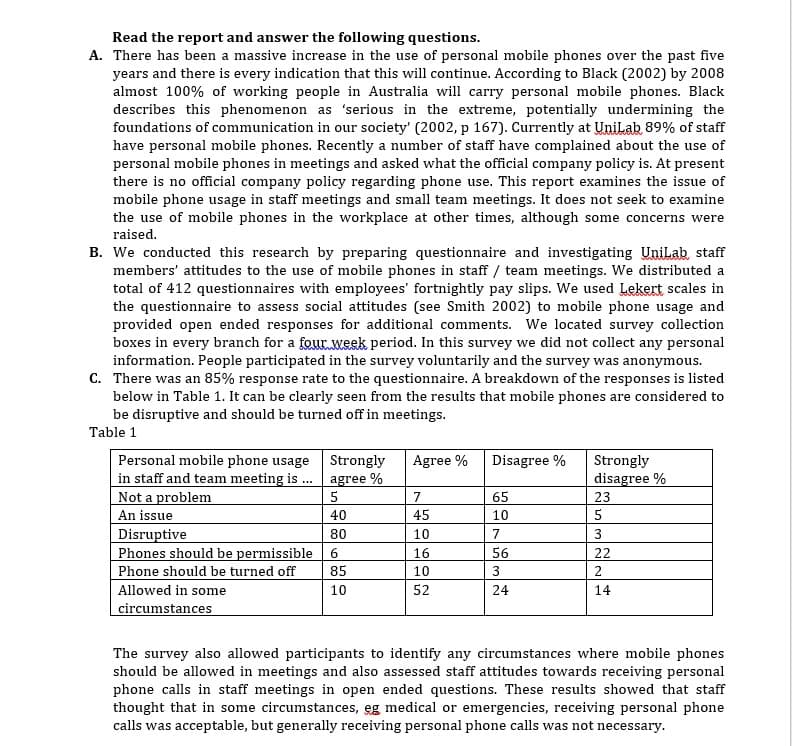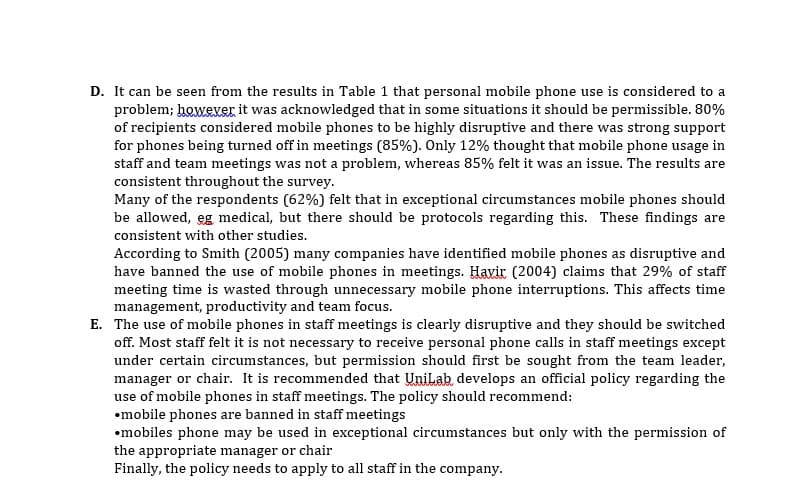Write down the name of the sections of the report. (a) What questions are answered in each section? Write one specific question and one general question for each section.
Write down the name of the sections of the report. (a) What questions are answered in each section? Write one specific question and one general question for each section.
Chapter6: Demand Relationships Among Goods
Section: Chapter Questions
Problem 6.6P
Related questions
Question
- Write down the name of the sections of the report.
(a) What questions are answered in each section? Write one specific question and one general question for each section.

Transcribed Image Text:Read the report and answer the following questions.
A. There has been a massive increase in the use of personal mobile phones over the past five
years and there is every indication that this will continue. According to Black (2002) by 2008
almost 100% of working people in Australia will carry personal mobile phones. Black
describes this phenomenon as 'serious in the extreme, potentially undermining the
foundations of communication in our society' (2002, p 167). Currently at Unilab 89% of staff
have personal mobile phones. Recently a number of staff have complained about the use of
personal mobile phones in meetings and asked what the official company policy is. At present
there is no official company policy regarding phone use. This report examines the issue of
mobile phone usage in staff meetings and small team meetings. It does not seek to examine
the use of mobile phones in the workplace at other times, although some concerns were
raised.
B. We conducted this research by preparing questionnaire and investigating UniLab staff
members' attitudes to the use of mobile phones in staff / team meetings. We distributed a
total of 412 questionnaires with employees' fortnightly pay slips. We used Lekert scales in
the questionnaire to assess social attitudes (see Smith 2002) to mobile phone usage and
provided open ended responses for additional comments. We located survey collection
boxes in every branch for a fourweek period. In this survey we did not collect any personal
information. People participated in the survey voluntarily and the survey was anonymous.
C. There was an 85% response rate to the questionnaire. A breakdown of the responses is listed
below in Table 1. It can be clearly seen from the results that mobile phones are considered to
be disruptive and should be turned off in meetings.
Table 1
Personal mobile phone usage
in staff and team meeting is .. agree %
Not a problem
An issue
Disruptive
Phones should be permissible 6
Phone should be turned off
Strongly
Agree %
Disagree %
Strongly
disagree %
7
65
23
40
45
10
80
10
7
3
16
56
22
85
10
3
2
Allowed in some
10
52
24
14
circumstances
The survey also allowed participants to identify any circumstances where mobile phones
should be allowed in meetings and also assessed staff attitudes towards receiving personal
phone calls in staff meetings in open ended questions. These results showed that staff
thought that in some circumstances, eg medical or emergencies, receiving personal phone
calls was acceptable, but generally receiving personal phone calls was not necessary.

Transcribed Image Text:D. It can be seen from the results in Table 1 that personal mobile phone use is considered to a
problem; however it was acknowledged that in some situations it should be permissible. 80%
of recipients considered mobile phones to be highly disruptive and there was strong support
for phones being turned off in meetings (85%). Only 12% thought that mobile phone usage in
staff and team meetings was not a problem, whereas 85% felt it was an issue. The results are
consistent throughout the survey.
Many of the respondents (62%) felt that in exceptional circumstances mobile phones should
be allowed, eg medical, but there should be protocols regarding this. These findings are
consistent with other studies.
According to Smith (2005) many companies have identified mobile phones as disruptive and
have banned the use of mobile phones in meetings. Havir (2004) claims that 29% of staff
meeting time is wasted through unnecessary mobile phone interruptions. This affects time
management, productivity and team focus.
E. The use of mobile phones in staff meetings is clearly disruptive and they should be switched
off. Most staff felt it is not necessary to receive personal phone calls in staff meetings except
under certain circumstances, but permission should first be sought from the team leader,
manager or chair. It is recommended that Unilak develops an official policy regarding the
use of mobile phones in staff meetings. The policy should recommend:
•mobile phones are banned in staff meetings
•mobiles phone may be used in exceptional circumstances but only with the permission of
the appropriate manager or chair
Finally, the policy needs to apply to all staff in the company.
Expert Solution
This question has been solved!
Explore an expertly crafted, step-by-step solution for a thorough understanding of key concepts.
Step by step
Solved in 2 steps

Knowledge Booster
Learn more about
Need a deep-dive on the concept behind this application? Look no further. Learn more about this topic, economics and related others by exploring similar questions and additional content below.Recommended textbooks for you


Principles of Economics 2e
Economics
ISBN:
9781947172364
Author:
Steven A. Greenlaw; David Shapiro
Publisher:
OpenStax

Principles of Microeconomics
Economics
ISBN:
9781305156050
Author:
N. Gregory Mankiw
Publisher:
Cengage Learning


Principles of Economics 2e
Economics
ISBN:
9781947172364
Author:
Steven A. Greenlaw; David Shapiro
Publisher:
OpenStax

Principles of Microeconomics
Economics
ISBN:
9781305156050
Author:
N. Gregory Mankiw
Publisher:
Cengage Learning

Principles of Economics (MindTap Course List)
Economics
ISBN:
9781305585126
Author:
N. Gregory Mankiw
Publisher:
Cengage Learning

Principles of Microeconomics (MindTap Course List)
Economics
ISBN:
9781305971493
Author:
N. Gregory Mankiw
Publisher:
Cengage Learning

Exploring Economics
Economics
ISBN:
9781544336329
Author:
Robert L. Sexton
Publisher:
SAGE Publications, Inc